Joy Neal Kidney's Blog, page 55
March 24, 2022
Dad’s Reverse Mohawk
 This is where it happened. The red stepstool.
This is where it happened. The red stepstool.
This is also where Mom undid my braids when I was a kid, and redid them every morning for school.
And Dad? There are two seasons of the year where farmers don’t have time to sit at the barber and wait for a haircut. Mom bought clippers with snap-on guide combs for the right length.
One time, only once, she forgot attach one, or it was the wrong one. Too late, she realized what she’d done.
Mom began to laugh!
Dad? Not so much. But they decided Mom should “even it up” as best she could. And he’d be wearing a cap most of the time anyway.
But in those days, a farmer would never wear a cap in the local cafe for coffee. Dad did, though, looking a little abashed.
A cap is a useful item for a farmer’s bad-hair day. Or week. Or longer.
Dad didn’t attend church until his hair grew out enough. But everyone in Dexter knew the story.
March 21, 2022
Sustenance (World Poetry Day)

portable radio on the Formica table,
Dad reading The Des Moines Register,
bib overalls and plaid shirt,
leather lace-up shoes, Rockford socks.
Lee Kline on WHO Radio's noon farm show,
news and weather and the farm markets,
Mom's white Youngstown kitchen cupboards,
sights and sounds of my childhood,
my teenage years.
That radio, Dad's spot at the table,
where often he'd make his own
childhood dessert, bread
crumbled in a glass of milk,
eaten with a spoon.
Then, folded arms on the table,
cradling his weary head, a power nap
before heading out for farmwork,
fortified by Mom's home cooking
and farm news from that portable radio.
March 18, 2022
Memoirs of “a Jewish Physician Who Took a Different Path”
“A Journey to feed your Soul. . . Give it time, give it space, give it thought,” writes H. Robert Rubin, M. D. on the back of one memoir. He has written three of them, each about 100 pages, over a five year period.
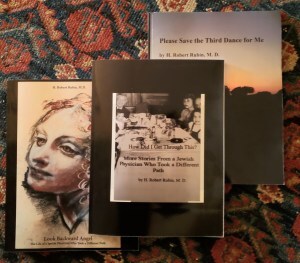
When all is said and done, how does a person process deep anger? How to effectively work through difficult truths about a parent? To live with a legacy of a father-son chain disfunction?
Though not written in a linear fashion, this memoir works through tough memories from childhood honestly. His vulnerability is compelling.
Dr. Bob Rubin examines his own life with candidness and humor. Honest about his own foibles, he shares his struggles and thoughts to connect with readers. He calls retirement a chance at a second childhood, but says that money and self-respect are also handy for this phase of life. A delightful collection of stories.
Please Save the Third Dance for Me
From coffee’s extraordinary dance to the idea of God’s hand in our lives. From behaving sophomorically as a sophomore to forgiveness as a process. This engaging memoir is so refreshing!

Dr. Rubin’s website
From Dr. Rubin’s post on March 15: “Patricia Hampl is an American memoirist. In describing memoir she calls it ‘A single voice singing its aria in a corner of the crowded world.’
“It is so true. We each have our stories. Those of us who write memoirs are trying to make music. That’s what we are after. We want to engage your imagination, your fascination, your sense of humor, your childlike wonder in listening to a story.
“It is singular. We each have our unique stories in time and place. At our best memoirists touch the reader deeply. When that happens we are singing a beautiful aria.”
I think you’d enjoy Dr. Rubin’s memoirs as well as his “Pilgrim on a Long, Long Journey” blog posts.
A quote from his recent post called “To Write”: “Writing is an art, a privilege, and a blessing.”
March 16, 2022
Old Pump Organs
During my growing up years, we worshiped at the Presbyterian Church in Dexter, where my Aunt Nadine (Neal) Shepherd was the pianist, organist (a pump organ), and choir director. Because so many choir members were from farm families, several months during the year, the choir became smaller.
We Neal cousins went to the Dexter school, just a couple of blocks from the church. Dexter had such a wonderful music teacher, Ruth Sellers, so in no time at all we could read music. Several of us also took piano lessons. Aunt Nadine recruited us for a youth choir, which eventually became the main choir.
When I was a junior in high school, Aunt Nadine was pregnant and needed substitutes at the organ and piano. I’d played piano for Sunday School, but the organ was a pump organ. That means that while you’re playing the keyboard, you also need to pump the bellows that made it play!
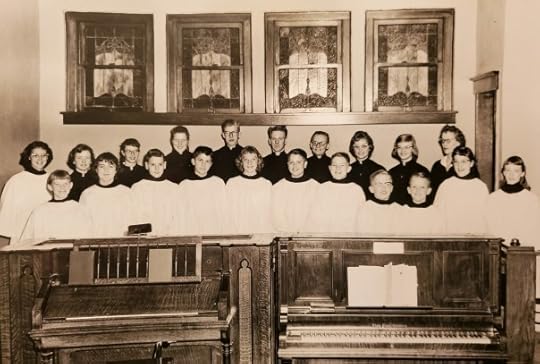 The pump organ is the instrument on the left. (The rear-view mirror is to be able to coordinate music with ushers, the pastor, and even when the choir processed in from behind the organist. I’m in the back row, second from left. My sister is on the front right. Eight of us are Neal cousins! Aunt Nadine is at the back right. Taken about 1961, First Presbyterian Church, Dexter, Iowa
The pump organ is the instrument on the left. (The rear-view mirror is to be able to coordinate music with ushers, the pastor, and even when the choir processed in from behind the organist. I’m in the back row, second from left. My sister is on the front right. Eight of us are Neal cousins! Aunt Nadine is at the back right. Taken about 1961, First Presbyterian Church, Dexter, IowaThe keys operate reeds, so when you press the key, air from the bellows flows up the reed and makes a sound. You can change the sound by using the stops, which are pull knobs that add extra features. The expression “pull out all the stops” refers to using all the knobs of an organ at the same time.
The Dexter church eventually traded the pump organ for a Hammond electronic organ, which I enjoyed playing, but if I’d had the money at the time, I would still own that old pump organ. I enjoyed playing it and had figured out how to repair the bellows when needed it.
A Depression-Era Pump Organ
While working on Leora’s Dexter Stories: The Scarcity Years of the Great Depression, I became acquainted with Mary Wilt, a neighbor of the Wilsons back then. She knew that Leora Wilson could play the piano and that the Wilson girls played in the Dexter band, so she said they could have her pump organ since she didn’t play it anymore.
The surprise was that the Wilson family was so strapped for life’s necessities, there was hardly money for extras. They had even needed to burn furniture so they could heat part of the house they rented.
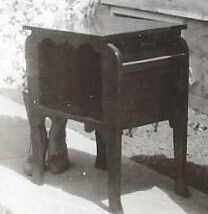 Dale needed a project for manual training. He transformed wood from that old organ into a radio table.
Dale needed a project for manual training. He transformed wood from that old organ into a radio table.
Leora’s Dexter Stories: The Scarcity Years of the Great Depression
March 14, 2022
Emelia Ann, Grandmother of Leora Goff Wilson
Emelia Ann Moore was born December 27, 1846. The next day, Iowa became the 29th State of the Union.
Emelia moved to the new state with her parents and siblings when she was nine years old.
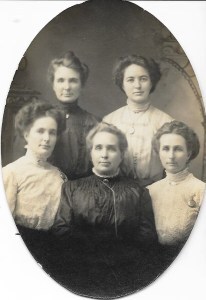 Emelia Jordan with her daughters, 1907 or 1908. Standing: Laura Jordan Goff, Cora Jordan Parrish. Seated: Lottie Jordan Anderson, Emelia, and Floy Jordan Cowden
Emelia Jordan with her daughters, 1907 or 1908. Standing: Laura Jordan Goff, Cora Jordan Parrish. Seated: Lottie Jordan Anderson, Emelia, and Floy Jordan CowdenShe married David Jordan in 1868, and became the parents of ten children. My great grandmother, Laura Jordan Goff, was their firstborn.
Laura’s next three siblings died while still youngsters. When Laura was eight years old, a sister was born who would grow to adulthood with her, along with five more children.
After Emelia was widowed in 1913, her oldest granddaughter Leora stayed at Monteith. They stopped in town to visit Emelia’s youngest son, Fred Jordan, who was Leora’s young uncle. Fred was married to Rectha, whose brother was Clabe Wilson.
That’s how Leora and Clabe met!
I am the keeper of Emelia’s vinegar cruet, a small plate with poppies, and a birthday card she sent her granddaughter Leora before 1911.


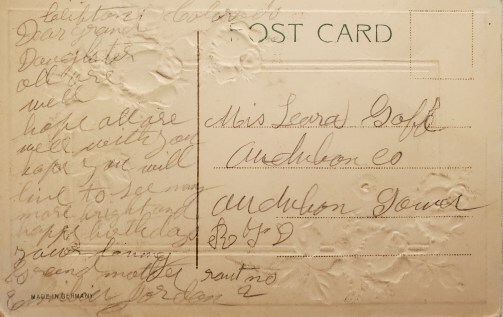 Clifton, Colorado (visiting a son’s family there). Dear Grand Daughter all are well hope all are well with you hope you will live to see many more bright and happy birthdays your loving Grandmother Emilia Jordan. To Mis [sic] Leora Goff, Audubon Co, Audubon, Iowa RFD, Rout [sic] no 2The only thing better than an heirloom, is an heirloom from you motherline!
Clifton, Colorado (visiting a son’s family there). Dear Grand Daughter all are well hope all are well with you hope you will live to see many more bright and happy birthdays your loving Grandmother Emilia Jordan. To Mis [sic] Leora Goff, Audubon Co, Audubon, Iowa RFD, Rout [sic] no 2The only thing better than an heirloom, is an heirloom from you motherline!
March 12, 2022
What do you think?
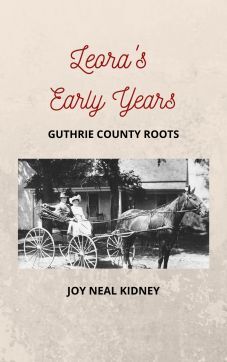 I just finished the third draft of Leora’s Early Years. Before I dive in for more sculpting, I’m thinking about the cover, and especially the title.
I just finished the third draft of Leora’s Early Years. Before I dive in for more sculpting, I’m thinking about the cover, and especially the title.
What do you think?
Leora’s Early Years: Guthrie County RootsLeora’s Guthrie County Roots: Girlhood to 1920sLeora’s Early Years: Girlhood to 1920sLeora’s Early Years: Pioneer Stock to 1920sMost of the stories are from all those Guthrie County years, where her ancestors pioneered. There are a couple of years in Nebraska, a couple in Minnesota, and half a dozen in Audubon County, but her father kept returning to their roots.
March 11, 2022
Bishop’s Cafeteria in Des Moines
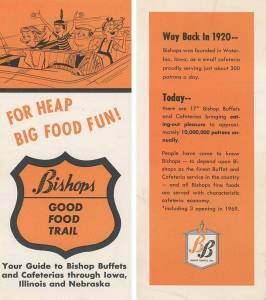 Benjamin Franklin Bishop, born in1873, grew up in Iowa. He married, worked in hotels, and settled in Waterloo in 1920, where he started his chain of cafeterias.Mr. Bishop died in 1928 at the age of 55, but eventually there were Bishop’s Buffets in 35 Midwestern locations.A waitress always carried your tray to your table. Each child’s tray was embellished by a balloon, held up with cardboard feet. Sis Gloria, who was small for her age well into high school, was mortified when they’d give her a balloon when she though she was too old for one.
Benjamin Franklin Bishop, born in1873, grew up in Iowa. He married, worked in hotels, and settled in Waterloo in 1920, where he started his chain of cafeterias.Mr. Bishop died in 1928 at the age of 55, but eventually there were Bishop’s Buffets in 35 Midwestern locations.A waitress always carried your tray to your table. Each child’s tray was embellished by a balloon, held up with cardboard feet. Sis Gloria, who was small for her age well into high school, was mortified when they’d give her a balloon when she though she was too old for one. Similar to the cardboard feet that held a balloon for a child’s tray.Dad almost always chose fried fish and a hard roll.Gloria, every single time, snapped up a slice of chocolate pie with the chocolate curls on top.
Similar to the cardboard feet that held a balloon for a child’s tray.Dad almost always chose fried fish and a hard roll.Gloria, every single time, snapped up a slice of chocolate pie with the chocolate curls on top. The last of the Bishop’s closed in 2012, but so many of us are still nostalgic about those iconic buffets.
The last of the Bishop’s closed in 2012, but so many of us are still nostalgic about those iconic buffets.
March 9, 2022
“Yes! All Can!” by Elaine Briggs
Yes! All Can!
 This is one teacher’s true story of three classes she creates, as well as her students’ accomplishments. Elaine Briggs shares a roadmap for her Reading, Peer Mediation, and Leadership classes.
This is one teacher’s true story of three classes she creates, as well as her students’ accomplishments. Elaine Briggs shares a roadmap for her Reading, Peer Mediation, and Leadership classes.
This energetic teacher discovers Evidence-Based Literacy Instruction (EBLI), which revolutionizes the teaching of reading for all ages. Those strategies dramatically raise reading levels of high schoolers and the elementary students they tutor, winning the Excellence and Michigan’s Best awards.
Yes! All Can! is for teachers, parents, and those who care about making a lasting difference. Join Elaine on this uplifting journey.
 Elaine Briggs earned an Elementary Education degree K-8, Master in Reading K-12 at Eastern Michigan, and Special Education Emotional Impairment Certificate K-12 at Toledo University. She taught at Milan Federal Correctional Institution, Boysville Juvenile Delinquency Center, and Milan High School. She is retired and lives with her husband on their farm near Milan, Michigan.
Elaine Briggs earned an Elementary Education degree K-8, Master in Reading K-12 at Eastern Michigan, and Special Education Emotional Impairment Certificate K-12 at Toledo University. She taught at Milan Federal Correctional Institution, Boysville Juvenile Delinquency Center, and Milan High School. She is retired and lives with her husband on their farm near Milan, Michigan.
The Foreword to her book was written by John Corcoran, author of The Teacher Who Couldn’t Read, The Reading Gap, and The Bridge to Literacy.
Yes! All Can! is available here.
—–
My thoughts: In this valuable book, Elaine presents her awesome successes in reading and leadership, which worked so well in such a short time. Dozens of former students share how her methods have influenced them. So many of them are already passing them on to another generation.
The inviting Foreword is by noted educator John Corcoran, who learned to read as an adult. The Appendices include specific activities and enrichments utilized, along with a two-page Bibliography.
May this captivating book have a great impact on future education of our kids!
Elaine Briggs has also written a biography about her amazing father, who grew up during the Great Depression, was commander of a battalion with the 741st Tank Battalion during the Battle of the Bulge, awarded medals (Purple Heart, Distinguished Service Cross, and Bronze Star) as, and went on to have a career with General Motors. Joe Dew: A Glorious Life.
March 7, 2022
The Monteith Church
Leora Goff Wilson’s mother grew up half a mile west of the village of Monteith, Iowa. After she married and had her own family, her firstborn (Leora) loved visiting her Grandpap and Grandmother Jordan there.
Leora was born in 1890, so was an adult by the time David and Emelia Jordan needed extra help, in 1912, and attended the Monteith church with them. After Grandpap Jordan died in 1913, Emelia moved into the little town of Monteith, where her youngest son, Fred Jordan, lived with his wife, Rectha.
Rectha’s older brother was Clabe Wilson, who visited them one day when Leora Goff was there with her grandmother. Their first date was to a Chautauqua in July.
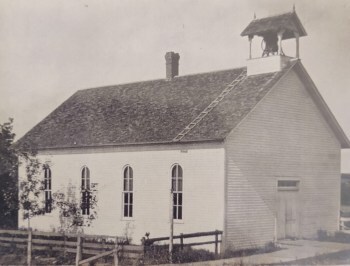
On Christmas Eve, Clabe attended the Christmas sermon and program in this church with Leora and her grandmother. Later that evening, he gave Leora a silver vanity set for Christmas – mirror, brush, and comb.
“Oh dear. Clabe, I didn’t get you anything.”
“I know something I’d like to have,” Clabe told her. “The Home Sweet Home that you painted.”
She gladly gave him the painting on velvet, with red roses entwined with the words.
He also asked her to be his bride. She said yes.
Historic Guthrie County Facebook Page
Monteith is in Guthrie County, so several people have posted photos and memories about the town. One day a centennial plate for the Monteith church was posted, along with something very special taped to the back of it.
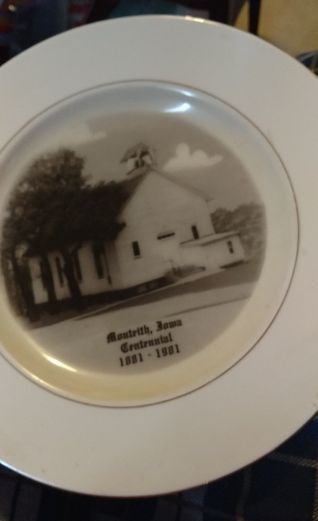
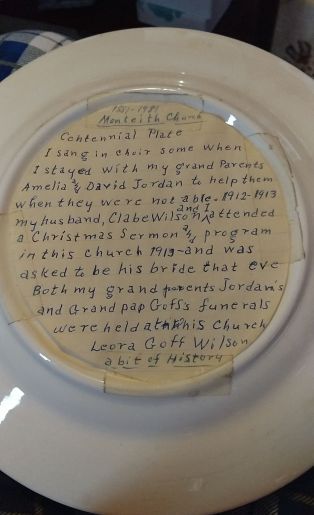 In my grandmother’s printing: “1881-1981 Monteith Church Centennial Plate
In my grandmother’s printing: “1881-1981 Monteith Church Centennial Plate
“I sang in choir some when I stayed with my grandparents Amelia [sic] and David Jordan to help them when they were not able. 1912-1913 My husband, Clabe Wilson and I attended a Christmas sermon and program in this church 1913 – and was asked to be his bride that eve Both my grandparents [David and Emilia] Jordan’s and Grandpap [John B.] Goff’s funerals were held at this church
“Leora Goff Wilson
a bit of History”
—–
My guess is that the plate was auctioned off when Grandma Leora’s things were sold in 1988. What a treasure, with that history in her own handwriting. John B. Goff died in 1909. Grandpap David Jordan was a well-loved pastor. Leora said that at his funeral, horses and buggies lined the dirt roads as far as you could see.
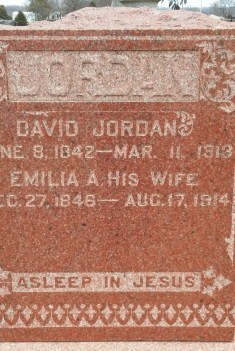
ASLEEP IN JESUS
March 4, 2022
Clabe Wilson’s Siblings
Five children were born to Daniel Ross Wilson and Georgia (Williams, Davis) Wilson. (Georgia was married and divorced, with a son born in 1882, who lived with her parents. See below.)
I have no photos of Dan and Georgia Wilson together, or either of them with family members.
Dan Wilson died in 1909, Georgia in 1917. Their youngest, Fonnie and Verna, were orphaned when they were 14 and 10.
Here are the Wilson children:
 Rectha, Clabe, and Alice Wilson, Guthrie County, Iowa
Rectha, Clabe, and Alice Wilson, Guthrie County, Iowa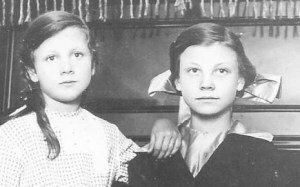 Verna and Fonnie Wilson
Verna and Fonnie WilsonFonnie and Verna Wilson had stayed with their older sisters some even while their mother was still living. They moved to The Retreat in Des Moines with her until it was decided that Georgia was getting much worse.
Georgia was transferred to the Clarinda State Hospital where she died two weeks after being admitted there.
The courts named a legal guardian to oversee funds from the sale of Georgia’s house in Panora, and rental of the farm. Fonnie finished her schooling in Guthrie Center, if I remember right, and worked in Des Moines. Verna lived mostly with Rectha in Colorado, but she eventually got a job in Des Moines. I’m amazed at the resilience of these two young girls.
Here’s a little about each one when they were older:
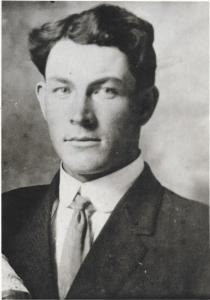 Claiborne Daniel Wilson (b. 1888)
Claiborne Daniel Wilson (b. 1888)
Clabe and Leora were married and had two small sons, when his mother died. Verna lived with them for a time, before she moved to Colorado to live with Rectha. Clabe and Leora had seven children.
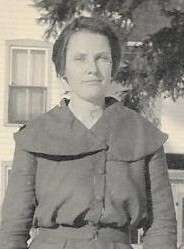 Rectha (Wilson, Jordan) Kansgen
Rectha (Wilson, Jordan) KansgenRectha Mae Wilson (1890)
Rectha was married to Leora’s uncle, Fred Jordan. They had two sons, the oldest named Leonard Clabe Jordan. They moved to Colorado, where another son was born. Rectha was widowed there. She remarried (to Wilbur Kansgen) and had four more children.
Alice Madeline Wilson (1891)
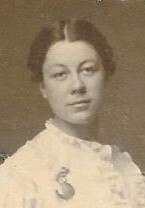 Alice (Wilson) McLuen
Alice (Wilson) McLuenAlice married Ed McLuen and lived at Stuart. They had a son and three daughters. One of her granddaughters said that Alice seemed like an unhappy woman.
—–
Florence Fern “Fonnie” Wilson (1903)
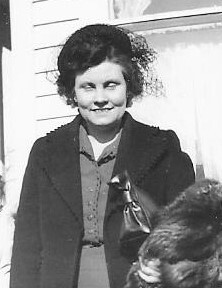 Fonnie (Wilson) Kiggen
Fonnie (Wilson) KiggenFonnie married Joseph Kiggen in Des Moines and moved to Massachusetts, where their six children were born. Fonnie returned to Iowa and visited Clabe and Leora (and probably her sisters Alice and Verna) at least twice.
Verna Pauline Wilson (1907)
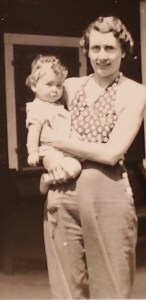 Joanne and Verna (Wilson) Parrot
Joanne and Verna (Wilson) ParrotVerna married Ralph Parrott. They lived in Des Moines and had a daughter, Joanne.
The older step-brother, Fred Davis, married and had four children.
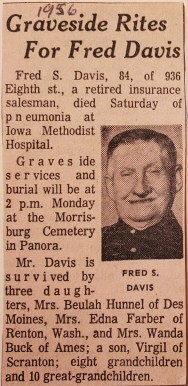
 In wonder where this photo was taken. Was it at their mother’s in Panora? How I’d love to see the photos on top of this piano! I can tell that the wedding photo toward the right is of Clabe and Leora.
In wonder where this photo was taken. Was it at their mother’s in Panora? How I’d love to see the photos on top of this piano! I can tell that the wedding photo toward the right is of Clabe and Leora.Thanks to distant cousin, Dave Anderson, who’s been skillfully hosts the Harris-Smith/Williams-Rogers Family Tree Facebook page and has generously shared details with me.
The more you know about your grandparents, the more you will know about yourself. – Rick Friday



